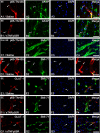Tumor necrosis factor-α-mediated threonine 435 phosphorylation of p65 nuclear factor-κB subunit in endothelial cells induces vasogenic edema and neutrophil infiltration in the rat piriform cortex following status epilepticus
- PMID: 22240205
- PMCID: PMC3312845
- DOI: 10.1186/1742-2094-9-6
Tumor necrosis factor-α-mediated threonine 435 phosphorylation of p65 nuclear factor-κB subunit in endothelial cells induces vasogenic edema and neutrophil infiltration in the rat piriform cortex following status epilepticus
Abstract
Background: Status epilepticus (SE) induces severe vasogenic edema in the piriform cortex (PC) accompanied by neuronal and astroglial damages. To elucidate the mechanism of SE-induced vasogenic edema, we investigated the roles of tumor necrosis factor (TNF)-α in blood-brain barrier (BBB) disruption during vasogenic edema and its related events in rat epilepsy models provoked by pilocarpine-induced SE.
Methods: SE was induced by pilocarpine in rats that were intracerebroventricularly infused with saline-, and soluble TNF p55 receptor (sTNFp55R) prior to SE induction. Thereafter, we performed Fluoro-Jade B staining and immunohistochemical studies for TNF-α and NF-κB subunits.
Results: Following SE, most activated microglia showed strong TNF-α immunoreactivity. In addition, TNF p75 receptor expression was detected in endothelial cells as well as astrocytes. In addition, only p65-Thr435 phosphorylation was increased in endothelial cells accompanied by SMI-71 expression (an endothelial barrier antigen). Neutralization of TNF-α by soluble TNF p55 receptor (sTNFp55R) infusion attenuated SE-induced vasogenic edema and neuronal damages via inhibition of p65-Thr435 phosphorylation in endothelial cells. Furthermore, sTNFp55R infusion reduced SE-induced neutrophil infiltration in the PC.
Conclusion: These findings suggest that impairments of endothelial cell functions via TNF-α-mediated p65-Thr 485 NF-κB phosphorylation may be involved in SE-induced vasogenic edema. Subsequently, vasogenic edema results in extensive neutrophil infiltration and neuronal-astroglial loss.
Figures






References
-
- DeLorenzo RJ, Pellock JM, Towne AR, Boggs JG. Epidemiology of status epilepticus. J Clin Neurophysiol. 1995;12:316–325. - PubMed
-
- Sheen SH, Kim JE, Ryu HJ, Yang Y, Choi KC, Kang TC. Decrease in dystrophin expression prior to disruption of brain-blood barrier within the rat piriform cortex following status epilepticus. Brain Res. 2010;1369:173–183. - PubMed
Publication types
MeSH terms
Substances
LinkOut - more resources
Full Text Sources
Research Materials

